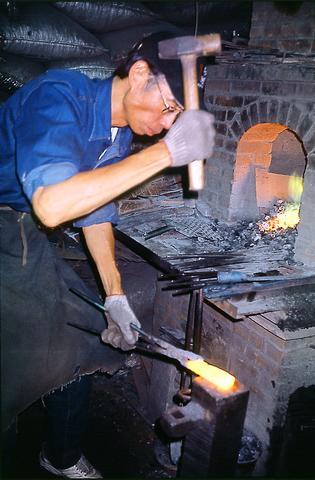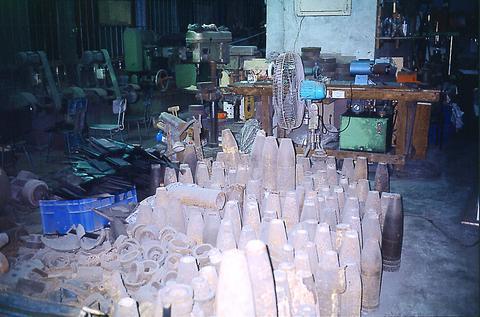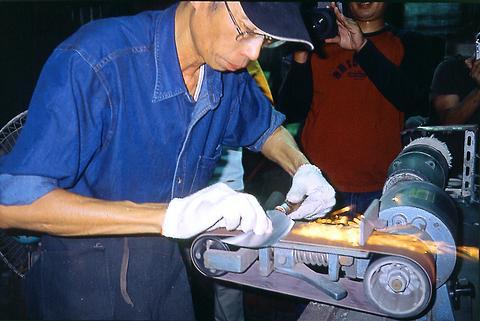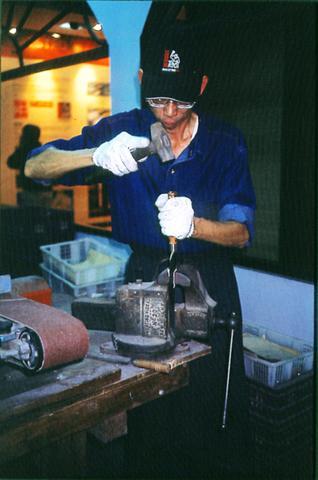In the 823 Artillery Bombardment (
What this has given Kinmen, in addition to many semi-collapsed buildings, is a huge cache of high-quality steel. In the hands of knife-maker Wu Tseng-dong (

PHOTOS: IAN BARTHOLOMEW, TAIPEI TIMES
The Chin Ho Li Steel Knife Factory (

Wu Tsong-shan, a quietly spoken bespectacled man, has spent over 30 years making knives and is the third generation of his family in the business. Wu recalled a childhood in which he would work the bellows of the forge when he got back from school, and serve as an assistant to his father and brothers around the smithy.
"In those days, production was very limited," he said. "But the knives we made were highly regarded, and would often be bought by soldiers stationed on the island and taken back to Taiwan. That's how our reputation grew."

In the early days, Wu's family made agricultural implements. Bombing of the island provided quality steel that literally dropped from the sky, and the Wu family shifted to making knives.

"Mostly we made butcher's knives. In the beginning, we would only take money after a person had used the knife and found it satisfactory. If it was unsatisfactory, we would replace it with another."
This input by Kinmen's butchers has been put to good use and now Wu's knives are definitely at the top end of the market. Sadly, perhaps, they are no longer used by local butchers, but have instead found their way into the kitchens of chefs working for major hotels in Taiwan and overseas. "Some have even provided specific designs for us," Wu said, "and we are gaining experience of their habits and needs."
While Wu does not claim any analytical knowledge of the materials he uses, his long familiarity with his materials has made him an expert in the subtle art of forging steel. "We must judge the heat of the steel very accurately. The color [of the red hot] steel tells us what we need to know ... this is part of the secret knowledge of our business," he said, with a mixture of pride and self-deprecation. "It all has to be judged very accurately."
Certainly, part of the appeal of Kinmen knives is in their association with history, but they would certainly not be so popular if they were not also of outstanding quality. The secret is in the fact that these knives are still forged and shaped by hand. "There is no comparison with mass-produced knives that are simply cut and ground from a metal board," he said. "It is the forging process that gives these knives their hardness and their ability to hold an edge."
The government has played a part in raising the profile of Kinmen knives. Since 1998 it has provided guidance about designing Western style knives and in 2000 assisted with a total revamp of labeling and packaging.
These days, "Maestro Wu" knives come in elegant display boxes and Wu says that they are increasingly developing extra-high-end knives for collectors.
"After all, one kitchen only needs a few knives, and our knives last a long time, so we have to expand the market in new directions."

Exceptions to the rule are sometimes revealing. For a brief few years, there was an emerging ideological split between the Democratic Progressive Party (DPP) and Chinese Nationalist Party (KMT) that appeared to be pushing the DPP in a direction that would be considered more liberal, and the KMT more conservative. In the previous column, “The KMT-DPP’s bureaucrat-led developmental state” (Dec. 11, page 12), we examined how Taiwan’s democratic system developed, and how both the two main parties largely accepted a similar consensus on how Taiwan should be run domestically and did not split along the left-right lines more familiar in

As I finally slid into the warm embrace of the hot, clifftop pool, it was a serene moment of reflection. The sound of the river reflected off the cave walls, the white of our camping lights reflected off the dark, shimmering surface of the water, and I reflected on how fortunate I was to be here. After all, the beautiful walk through narrow canyons that had brought us here had been inaccessible for five years — and will be again soon. The day had started at the Huisun Forest Area (惠蓀林場), at the end of Nantou County Route 80, north and east

This month the government ordered a one-year block of Xiaohongshu (小紅書) or Rednote, a Chinese social media platform with more than 3 million users in Taiwan. The government pointed to widespread fraud activity on the platform, along with cybersecurity failures. Officials said that they had reached out to the company and asked it to change. However, they received no response. The pro-China parties, the Chinese Nationalist Party (KMT) and Taiwan People’s Party (TPP), immediately swung into action, denouncing the ban as an attack on free speech. This “free speech” claim was then echoed by the People’s Republic of China (PRC),

Specialty sandwiches loaded with the contents of an entire charcuterie board, overflowing with sauces, creams and all manner of creative add-ons, is perhaps one of the biggest global food trends of this year. From London to New York, lines form down the block for mortadella, burrata, pistachio and more stuffed between slices of fresh sourdough, rye or focaccia. To try the trend in Taipei, Munchies Mafia is for sure the spot — could this be the best sandwich in town? Carlos from Spain and Sergio from Mexico opened this spot just seven months ago. The two met working in the